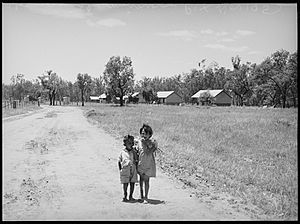List of Aboriginal Reserves in New South Wales facts for kids
Aboriginal reserves in New South Wales were special areas of land where many Aboriginal people were made to live. This happened because of laws and rules set by the British government, which used to control Australia, and later by the state governments. These governments had policies that separated people based on their race (called segregation) and tried to make Aboriginal people live like non-Aboriginal people (called assimilation).
The government created these reserves just for Aboriginal people. This practice continued even after Australia became a federation in 1901. Interestingly, out of 85 reserves made between 1885 and 1895, Aboriginal families themselves asked for 47 of them. Records from the NSW State Archives show maps and descriptions of these areas, sometimes even noting if they were good for hunting and fishing.
Different government groups managed these reserves over the years. These included the Aborigines Protection Board (from 1883 to 1940), the Aborigines Welfare Board (from 1940 to 1969), and the Aborigines Welfare Directorate (from 1969 to 1975).
Life on these reserves, and similar places like missions, meant that Aboriginal people were kept separate and controlled. They lost basic human rights, like being able to move freely or choose their own jobs. They also lost control over their personal belongings and even their children. In New South Wales, some reserves were set up because white residents complained about Aboriginal people living in towns or in camps on the edges of towns.
There were two main types of reserves. Some were "managed reserves," often called "stations." These usually had a manager or matron, and people living there received food and housing. Other reserves were "unmanaged." These only provided food and were looked after by the local police.
After World War I, some reserves were closed down. This might have been because land was being given to soldiers returning from the war.
By 1945, there were over 100 reserves. But between 1954 and 1964, more than 25 reserves were closed. This was likely due to the government's policies of assimilation, which aimed to move Aboriginal people into towns. In 1953, there were 19 reserves still managed by the board. Some, like the one in Moree, were even getting bigger with more houses. Sometimes, reserves were made larger, or parts of them were closed over time.
The system of reserves and stations finally ended with the Aborigines Act 1969. A new group, the Aboriginal Land Trust, was created in 1973. This Trust took over ownership of all Aboriginal reserves in New South Wales. Their job was to look after these lands for the benefit of Aboriginal people. The Trust was also responsible for the houses on the reserves. However, the Aboriginal Lands Trust was later closed down by the Aboriginal Land Rights Act 1983. The land then went to the Minister for Aboriginal Affairs and eventually to Aboriginal Land Councils.
In 1997, a new system called Indigenous Protected Areas (IPAs) started in Australia. The remaining Aboriginal Reserves in New South Wales are not automatically part of this new system.
Early Reserves: A Glimpse into the Past
In the 1870s and 1880s, some land reserves were officially set aside for specific Aboriginal individuals or families. These were often smaller areas. Here are a few examples:
- Amos Lewis and others (1875)
- W. Campbell (1875)
- Richard Bolway (1877)
- Merriman (1877)
- Yarboro (1877)
- Neddy (1878)
- Henry Roberts (1878)
- Mary Ann Willoughby (1879)
- James Murray (1879)
- William Benson (1880)
- Tommy Again (1880)
- John Ambrose (1874)
- Henry Wedge (1881, 1883)
- Billy Billy (1884)
- Margaret Bryant (1885)
- John Bell (1887, 1889)
Aboriginal Reserves in New South Wales (A-Z List)
Many Aboriginal reserves were created across New South Wales. This list shows some of them, along with when they were officially started and when they were closed. The "Gazette number" is like an official reference number for the reserve.
Reserves Starting with 'A'
| Reserve Name | Gazette Number | Date Started | Date Closed | Important Notes | Location (Parish and County) | References |
|---|---|---|---|---|---|---|
| Allgomera Aboriginal Reserve | AR 38,625 | 10/12/1904 | ? | Near Macksville on Tom Mara's Creek | Parish of Allgomera, County of Raleigh | |
| Angeldool Aboriginal Reserve | AR 41,025/6 | 07/11/1906 | 08/02/1944 | May have continued as a reserve after 1973 | Parish of Birruma, County of Narran | |
| Armidale Aboriginal Reserve | AR 81,255 | 21/11/1958 | 13/06/1975 | Parish of Armidale, County of Sandon | ||
| Armidale Aboriginal Reserve | AR 87,623 | 16/01/1970 | 27/09/1973 | Parish of Armidale, County of Sandon | ||
| Ashby Aboriginal Reserve | AR 31,665 | 03/11/1900 | 05/08/1927 | On the Broadwater and Clarence Rivers | Parish of Ashby, County of Clarence | |
| Ashford Aboriginal Reserve | AR 17,800 | 27/05/1893 | 20/12/1957 | Parish of Pindari, County of Arrawatta | ||
| Ashford Aboriginal Reserve | AR 40,459 | 02/05/1906 | 20/11/1925 | Sevington, Ashford area | Parish of Blbonbah, County of Arrawatta | |
| Ashford Aboriginal Reserve | AR 69,118 | 21/05/1940 | 26/07/1974 | Also known as Deadbird Mission or Tarrangower Reserve | Parish of Chapman, County of Arrawatta | |
| Ashford Aboriginal Reserve | AR 85,428 | 20/08/1965 | 27/09/1973 | Cooke Street location | Parish of Ashford, County of Arrawatta | |
| Ashford Aboriginal Reserve | AR 87,126 | 28/03/1969 | 07/02/1975 | Town Houses, Ashford | Parish of Ashford, County of Arrawatta |
Note: The full list of Aboriginal reserves is very long. This article provides a few examples to show the types of places that existed. For a complete list, please refer to the original, more detailed article.
See also


